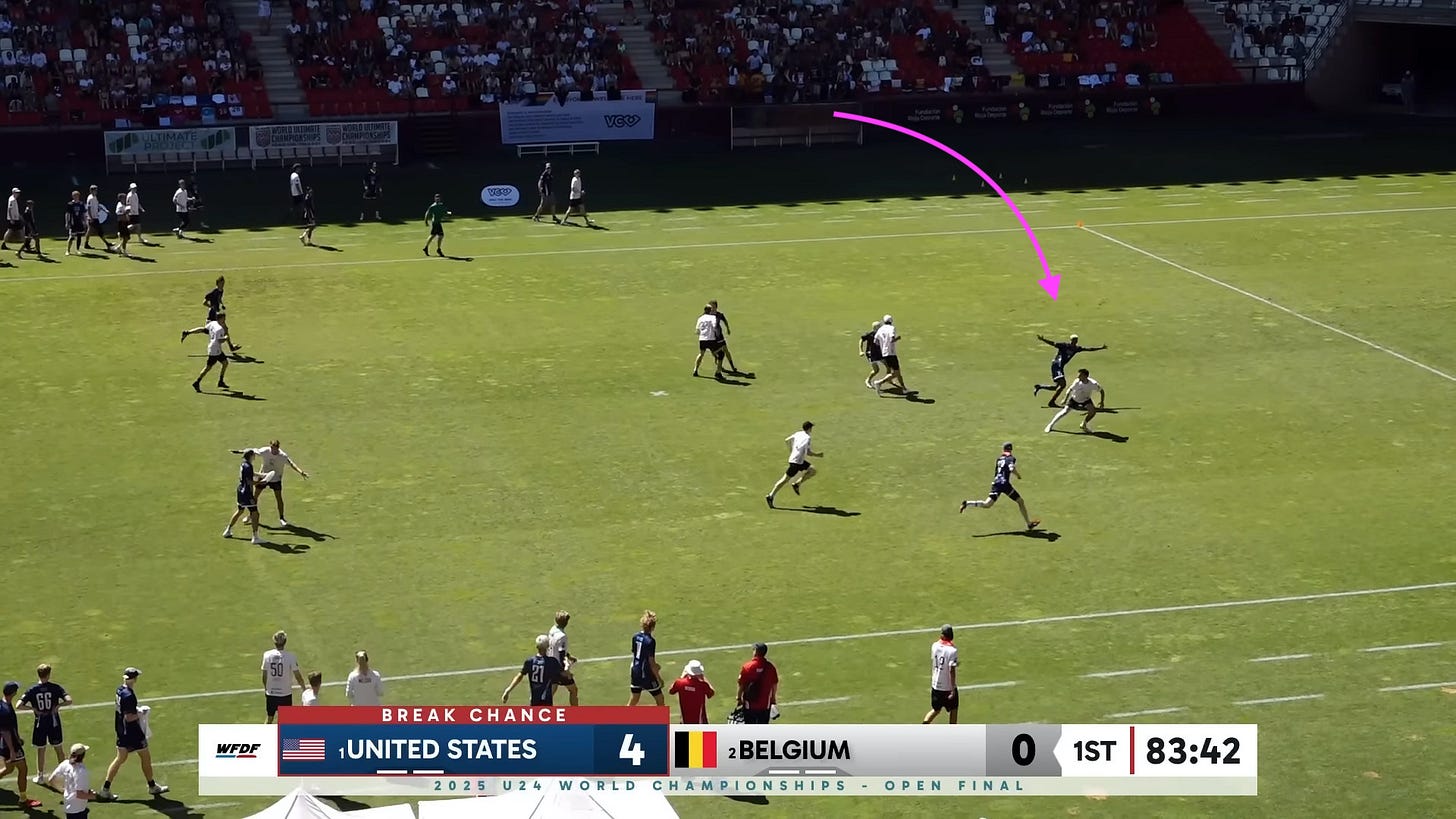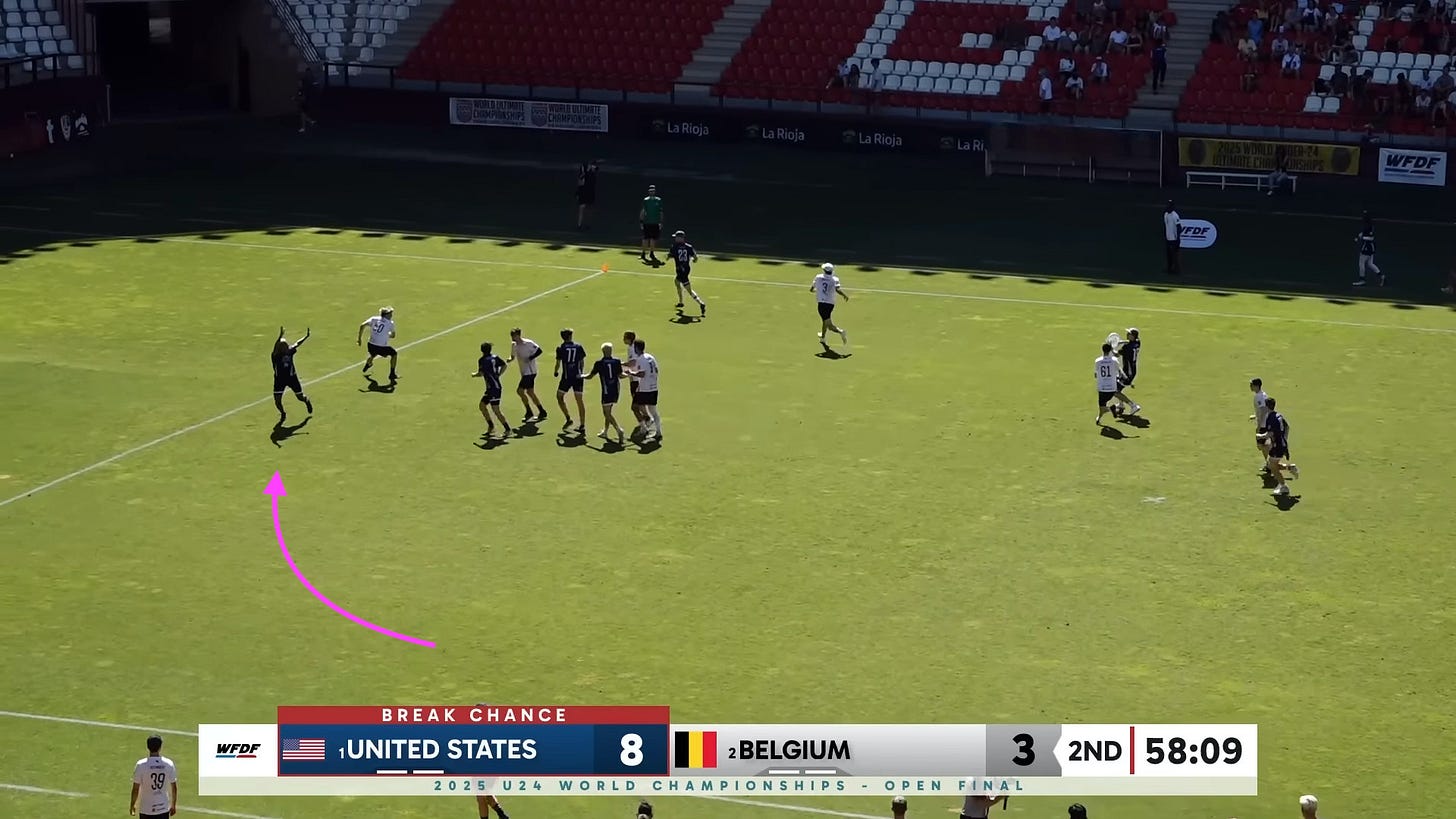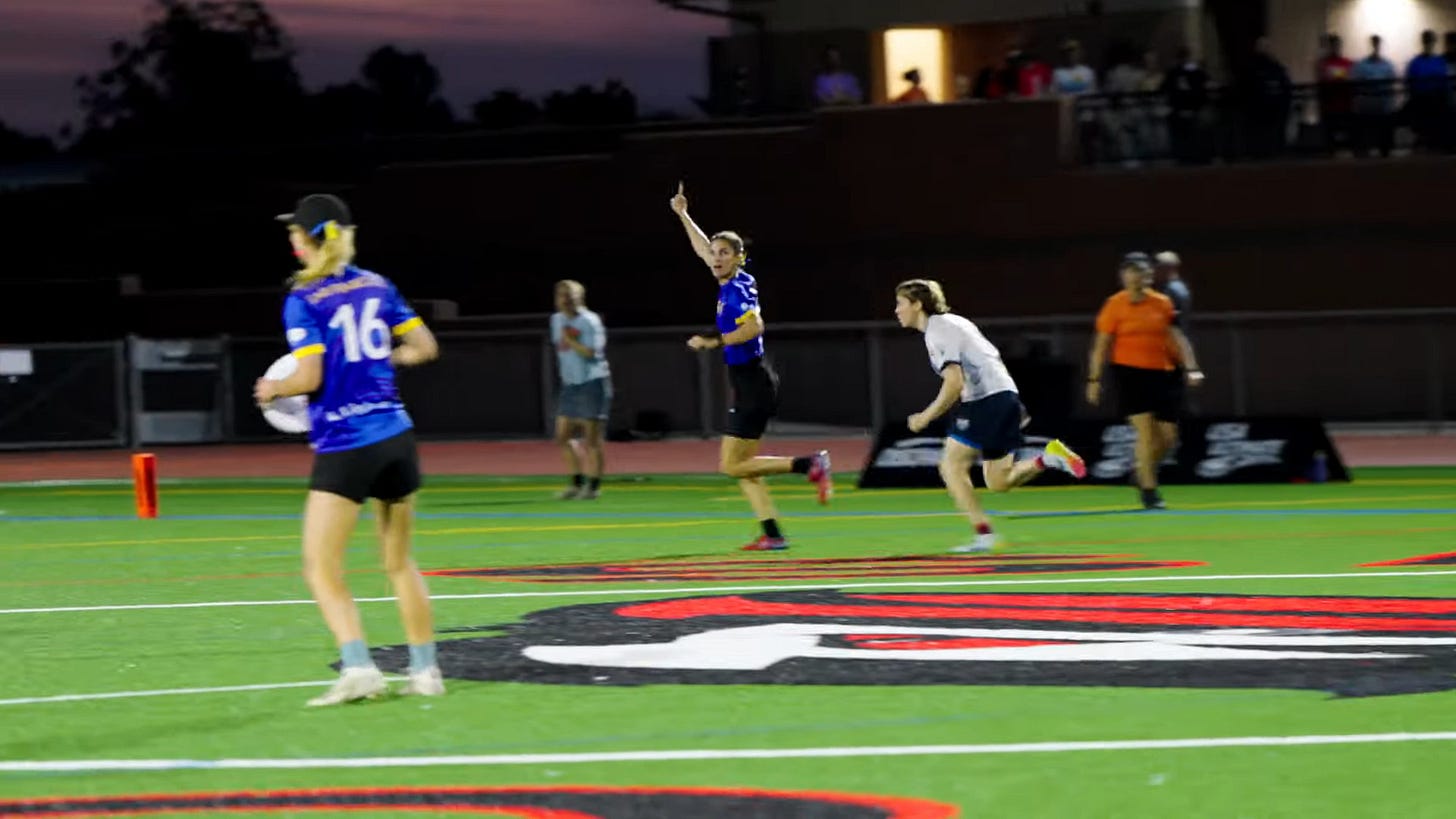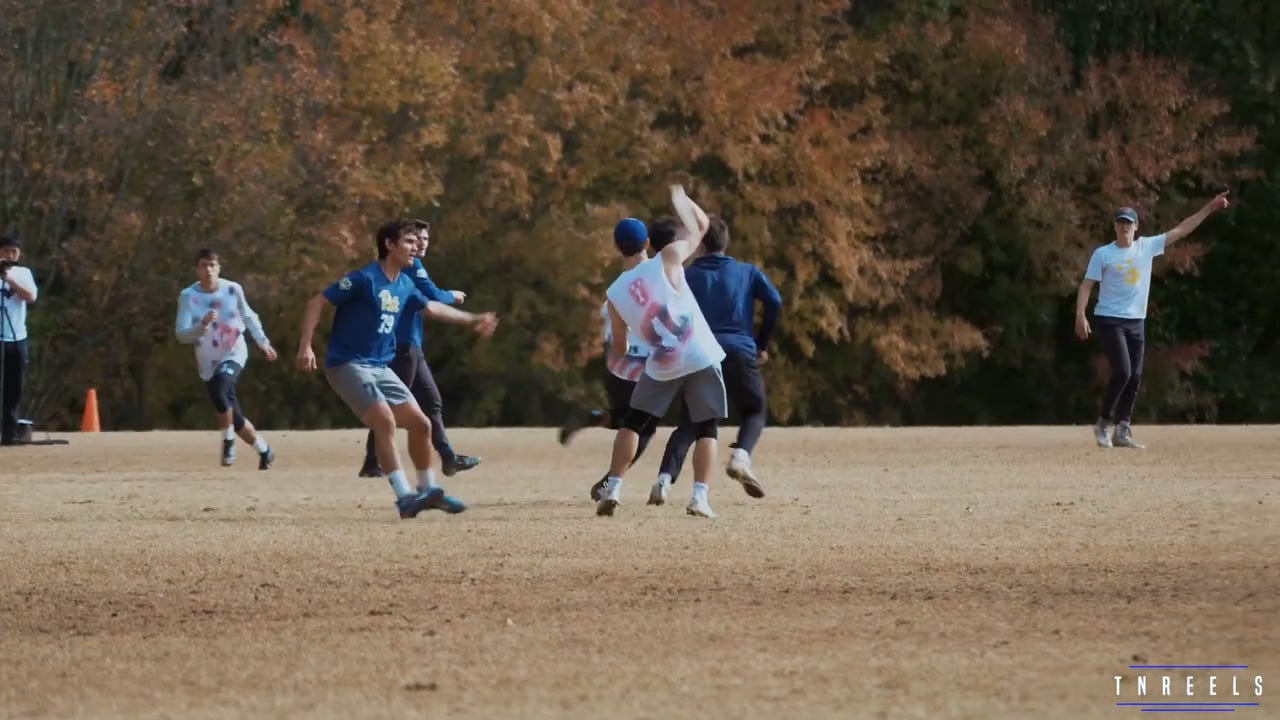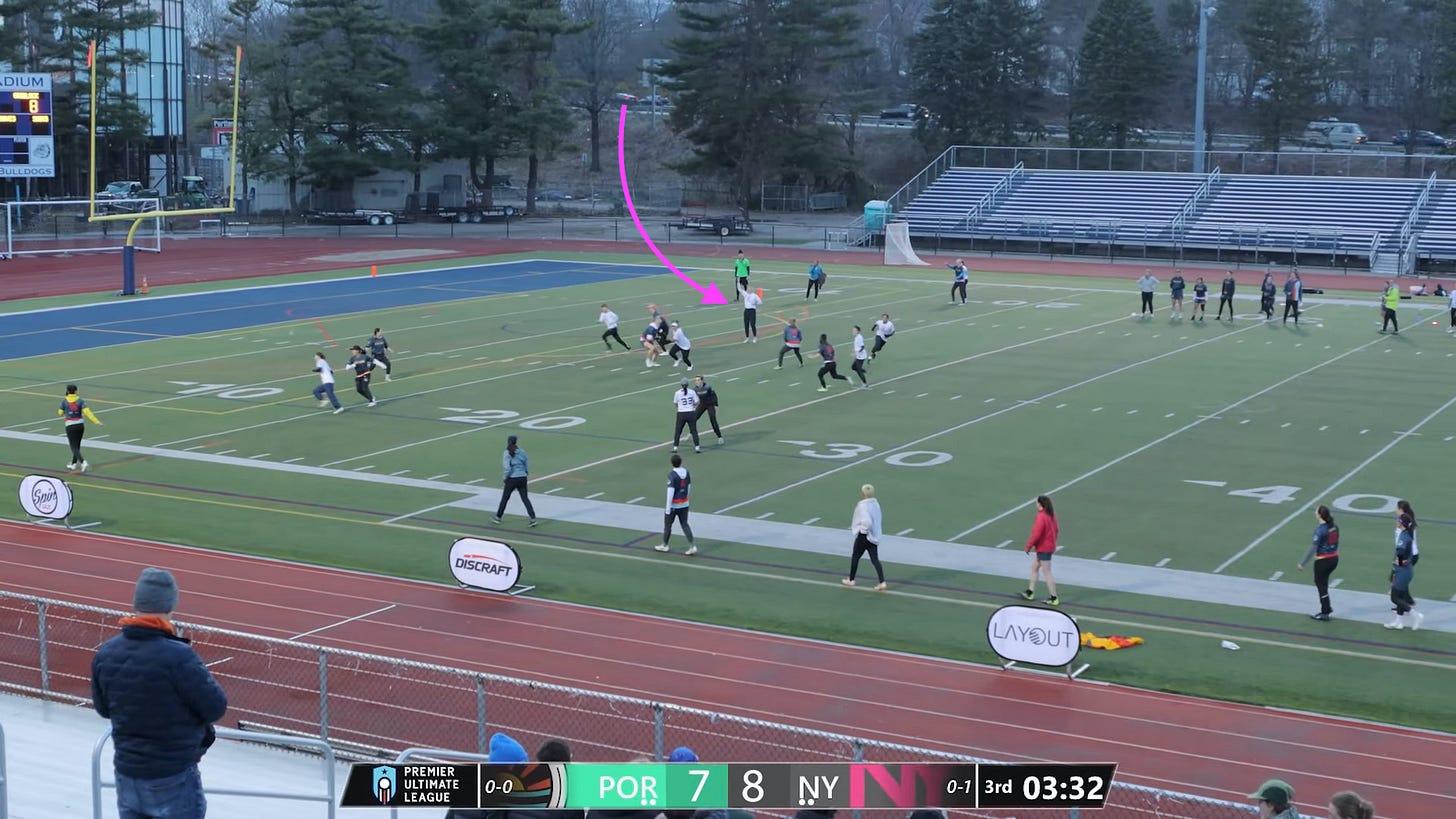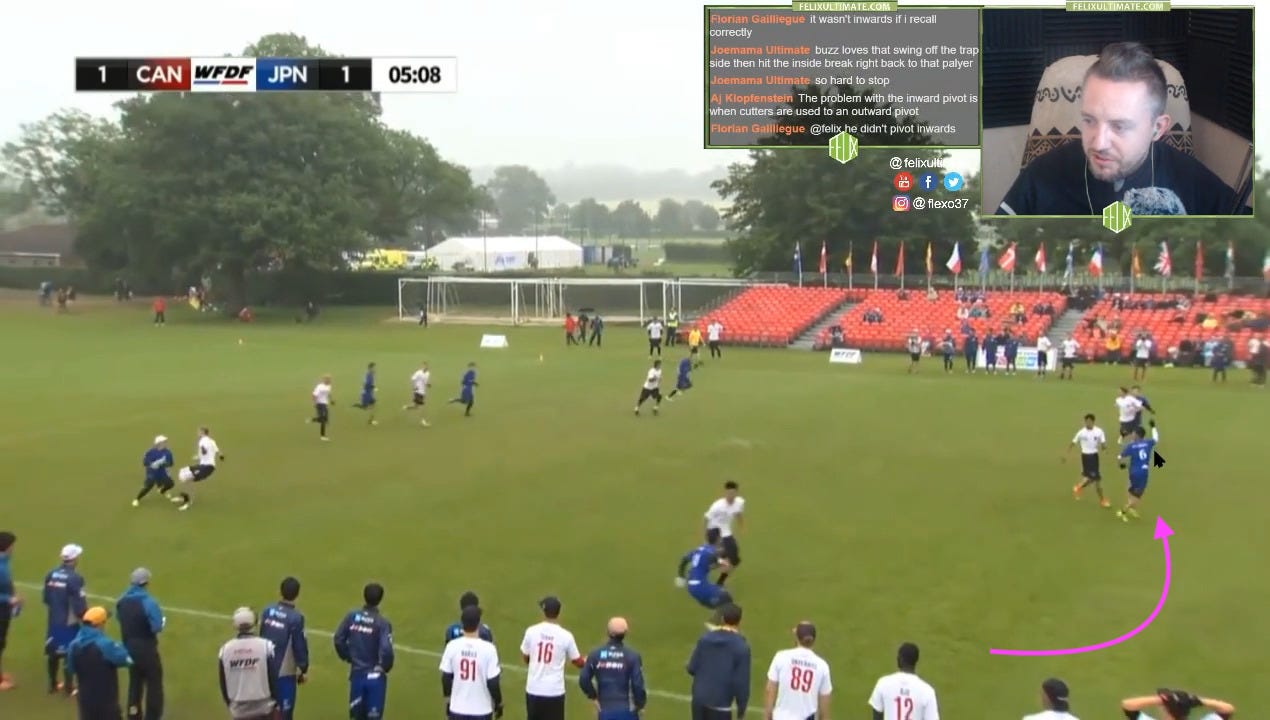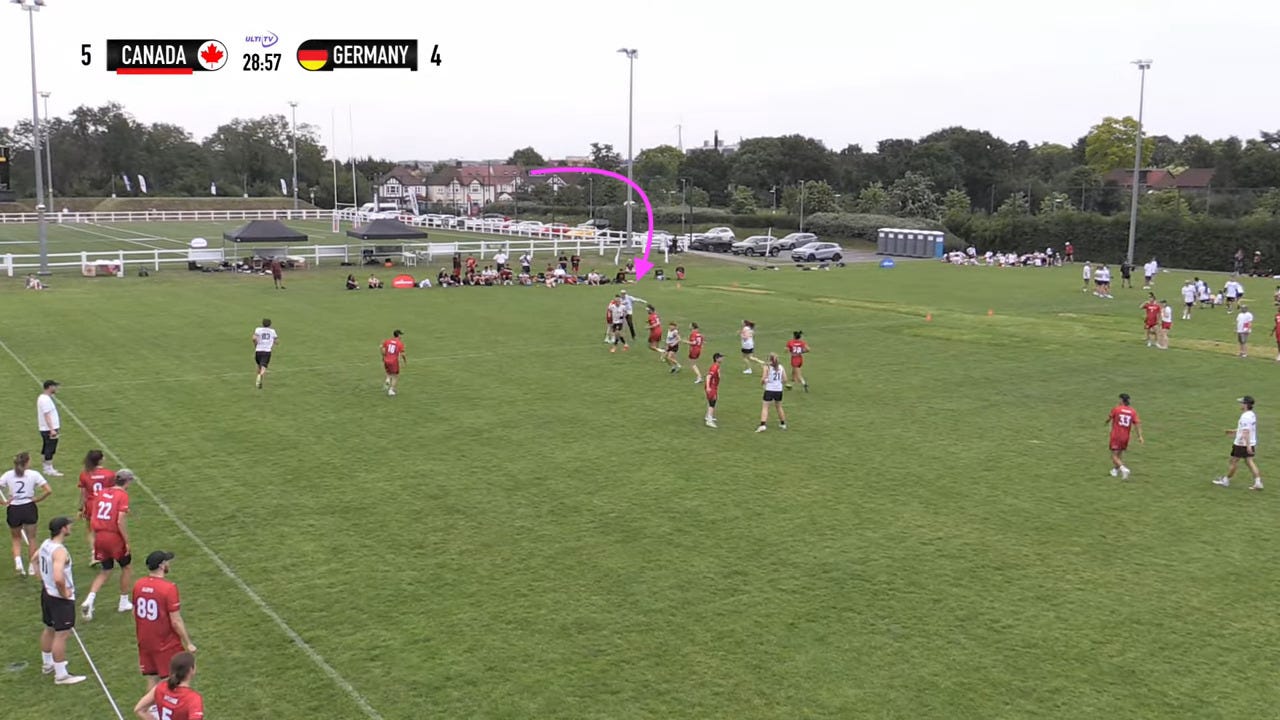One thing I feel like I've been appreciating more and more over the last few years: great players are low-key calling for passes all the time.
I'm calling this skill "offering" because, to me, there's a certain type of hand signals1 good players use that tells a thrower, hey, I see this space—and I'll cut into this space if you want to throw it there.
A thrower may see a possibility, but they won't feel confident throwing the pass unless they have some indication you, as the cutter, also are ready for that possibility. Offering is how you do that.
Even when it doesn't get you the disc, offering creates gravity. Simply looking like you're trying to get the disc will reduce the amount defenders sag off you. I'm going to poach less off a cutter who's waving their arms trying to get the thrower's attention than I would from a cutter who looks like they're not even trying to get thrown to.
Offering is a challenge for your field sense—you'll need to be constantly refreshing your understanding of which spaces around you are open.
When I first thought of writing an article like this, the title I had in mind was "Be ready for the space throw". Jack Williams touches on these ideas in his video "The Art of the Space Throw". He explains his thought process as a thrower as having an understanding of "where the cutter would win a footrace to". There's a symmetric skill that good cutters have—knowing at all times where you would win a footrace to, and being ever-ready for that footrace to start at a moment's notice. And, of course, offering your thrower the option of choosing that race. I think he is maybe underselling the role cutters play in initiating space throws—hence this article.
Good cutting communication is kind of like an ongoing negotiation between thrower and receiver. Dena Elimelech, in a clip below, is jogging down the field, maybe you could even call it running. But, at the moment she puts her hand up, she isn't really cutting deep. But her hand pointing downfield tells the thrower, I'm committed to this if you are. Kurono's hand signal (again, see below) has a similar effect, but he's barely even jogging. In this sense, offering is an energy saving technique too: you make your offers, and commit to the ones the thrower seems interested in, while not wasting energy on ideas the thrower doesn't like. (See: Don't not get thrown to)
Offering, in my experience, is especially useful in situations where the stall count starts getting higher. As a player looks off an option that's not open and starts scanning the field for someone to save them from getting stalled out, are you ready to be that savior? By the time they look at you, you should already have your arm up pointing to the space where they can put a throw to save the possession. I've saved lots of possessions for my teams just by having something to offer the thrower when they look at me needing help late in the stall count.
A bunch of examples
I loved this sequence from Dexter Clyburn in the recent U24 world championship game.
I doubt any coaches are out there teaching the "start an under cut, then attack the hammer space with two hands up asking for the throw" technique.
But it works for him. He recognizes open spaces and recognizes his teammates' skills. In fact, it worked well enough he did it again later in the game, although this time it was more of a horizontal jab to the open side followed by running to the break side with two hands up:
Here's another Team USA member, Lia Schwartz, offering to be ready for a blady flick over a zone in the U24 women's final (you can see her teammates doing the same earlier in the point, as well):
Here's a very brief clip of Dena Elimelech offering to commit to a deep cut:
John Randolph's Callahan video likewise has a blink-and-you'll-miss-it moment where the cutter downfield is showing John exactly where he wants the disc:
Here's a New York Gridlock player2 offering teammate Valeria Cardenas the hammer to the breakside. They do a great job of recognizing that they're poached and just gradually floating away into the empty space before asking for the pass:
I also love this clip from an old Hive video, where Felix breaks down a Team Japan sequence including Kurono offering a deep cut. As Felix says:
He's got, like, a yard of separation. He doesn't have any separation. And he just puts his hand up, like, "yeah, yeah, chuck it deep, it's cool, I'll get it"
Finally here's another very brief (but still accepted by the thrower) offer from the German World Games team at London Invite 2025:
Offering isn't just about hammers and deep shots—this is just an OI flick out to the side of what looks like a vertical stack. (Somewhat reminiscent of the play by Mel Dunn highlighted in this article). But the quick offer-and-throw turn the possession into an easy goal.
One thing I love about throws like this is that the defense has less time to react. If you're already cutting hard before the throw is released, your defender will also be running hard towards the spot the disc is heading to. But when you offer the pass and commit to the cut later, the defender has less time to respond. (Similar to a point I raised in Slowing at the saddle point).
There's a slight difference, in my mind, between offering and just 'calling for a pass'. Offering is telling your thrower "here's an idea, let's explore it further if you like it, too". Whereas calling for a pass is merely saying "hey dude, I'm open, throw it to me". Admittedly some of my examples blur the line between the two. But hopefully the general idea still shines through—how powerful it can be to show the thrower what your ideas are, without necessarily committing to those ideas immediately.
On that spectrum, the Lia Schwartz clip might be more of the 'calling for a pass' variety—she's so wide open that she doesn't really have to go anywhere and there's no defense they need to outsmart. Dena and Kurono are closer to the pure offering end of the spectrum—they're showing the thrower their ideas but not fully committing to them unless the thrower likes the idea too. Clyburn is somewhere in the middle, leaning towards offering—I think he's calling for the disc because he's open, but hammers are generally rare enough that any suggestion of a hammer is an offer more than a demand—I don't think he'd be overly let down if the throwers had chosen not to attempt those passes. Plus, he's not exactly cutting his hardest towards the breakside.
The hand signals highlighted recently You don't need to stare down your dump reciever could be thought of as a type of offering, too. The player in the reset space is saying to their thrower, "hey, I'm ready for the half-pivot dump throw if that's what you want to throw. And if you don't like it, we'll figure out the next thing."
One final situation that I haven't found a good clip of yet: when I'm at the front of a stack, I am always offering the thrower a throw to the breakside space (somewhat similar to the second example in Jack Willams's video @6:33, though I don't see anyone calling for the disc in that clip—and Jack himself says he's "trusting his receiver" to recognize what's happening). The throw to the breakside is so much more appealing when your thrower has visual confirmation that you think it's a good idea, too.
There are lots of players out there who'll find this article to be nothing but old news. But I also think many players—even those who play at a high level—would be surprised how much more you can get thrown to just by making it clear to your thrower that you're interested in getting the disc and showing them where you'd want it.
I continued to think communication (verbal and non-verbal) remains a vastly underrated skill on both offense and defense. For more on this topic, I also love Hive's video: The Secret to Belgium's Team Chemistry - Non-verbal Communication. Aside from a number my own articles that I've already linked above, Avoiding thrower/receiver miscommunications is another one on a similar topic.
You can also do something similar using facial expressions—e.g. raising your eyebrows at the thrower, nodding your head to the side slightly, etc. But that's even harder to find examples of...
Unfortunately I can't credit them by name because the camera never zooms in and the announcers don't mention the player by name...Sorry!
